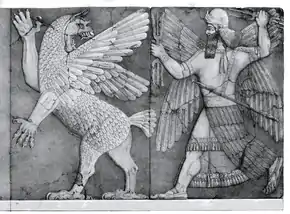| Part of a series on |
| Ancient Mesopotamian religion |
|---|
 Chaos Monster and Sun God |
|
|
Ur(i)dimmu, meaning "Mad/howling Dog" or Langdon's "Gruesome Hound",[1] (Sumerian: 𒌨𒅂UR.IDIM and giš.pirig.gal = ur-gu-lu-ú = ur-idim-[mu] in the lexical series ḪAR.gud = imrû = ballu), was an ancient Mesopotamian mythical creature in the form of a human headed dog-man whose first appearance might be during the Kassite period, if the Agum-Kakrime Inscription proves to be a copy of a genuine period piece. He is pictured standing upright, wearing a horned tiara and holding a staff with an uskaru, or lunar crescent, at the tip. The lexical series ḪAR-ra=ḫubullu describes him as a kalbu šegû,[2] "rabid dog".
Mythology
His appearance was essentially the opposite, or complement of that of Ugallu, with a human head replacing that of an animal and an animal's body replacing that of a human. He appears in later iconography paired with Kusarikku, "Bull-Man", a similar anthropomorphic character, as attendants to the god Šamaš. He is carved as a guardian figure on a doorway in Aššur-bāni-apli's north palace at Nineveh.[3] He appears as an intercessor with Marduk and Zarpanītu for the sick in rituals. He was especially revered in the Eanna in Uruk during the neo-Babylonian period where he seems to have taken on a cultic role, where the latest attestation was in the 29th year of Darius I.[4]
As one of the eleven spawn of Tiamat in the Enûma Eliš vanquished by Marduk, he was displayed as a trophy on doorways to ward off evil and later became an apotropaic figurine buried in buildings for a similar purpose.[5] He became identified as MUL- or dUR.IDIM with the constellation known by the Greeks as Wolf (Lupus).[6]
References
- ↑ S. Langdon (1923). The Babylonian Epic of Creation. Clarendon. p. 89.
- ↑ Benno Landsberger, Anne Draffkorn Kilmer (1962). The Fauna of Ancient Mesopotamia. Second Part: HAR-ra = hubullu. Tablets XIV and XVIII (MSL VIII/2). Pontificium Institutum Biblicum. p. 14. line 95.
- ↑ John Malcolm Russell (1992). Sennacherib's Palace Without Rival at Nineveh. University of Chicago Press. p. 183.
- ↑ Paul-Alain Beaulieu (2003). The Pantheon of Uruk During the Neo-Babylonian Period. Brill Academic Pub. pp. 355–358.
- ↑ Frans A.M.Wiggermann (1992). Mesopotamian Protective Spirits: The Ritual Texts. Styx. pp. 172–174.
- ↑ Urdimmu, CAD U/W pp. 214–216.